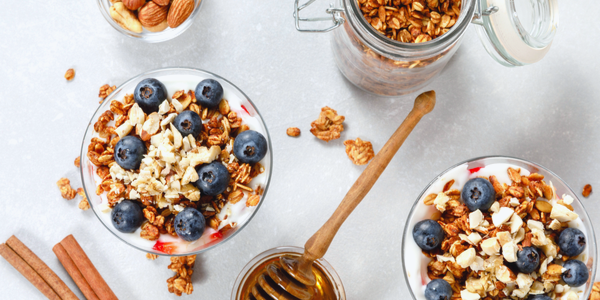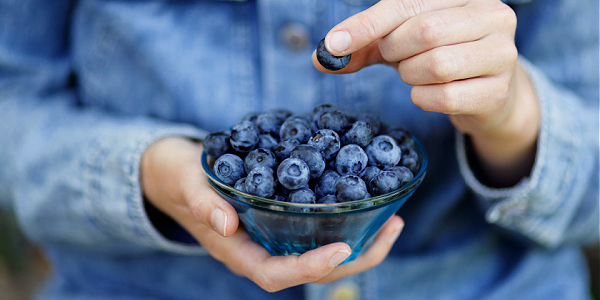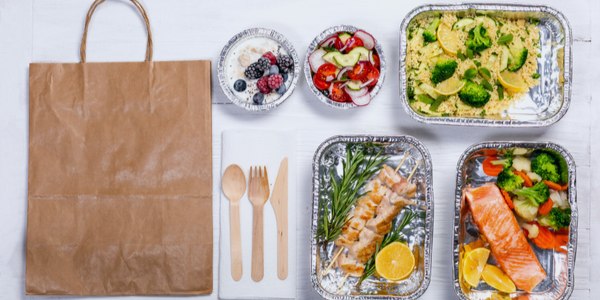
Snacking in between meals can certainly be part of a healthy diet or it can completely derail weight loss goals depending on the type of foods included. In general, the best snacks for weight loss will be high in fiber, protein, and/or omega-3 fatty acids and low in refined sugar and other "empty calories."
No need to wage war with unfulfilling snacks any longer. Refer back to this article for low-calorie snacks that double as the best snacks for weight loss.
How to Fit Snacking Into a Healthy Diet
Before providing explicit examples of healthy snack options, it is important to understand how to properly incorporate them into an eating plan.
Depending on how many calories one's allotted on their eating plan, snacks can serve as a bridge for nutritional gaps. Meaning, that they not only contribute calories but beneficial nutrients like fiber and antioxidants as well. That is, so long as the snacks are nutritionally dense.
Snacking tends to get a bad rap because typical snacks like chips, crackers, and cookies are high in refined sugar/carbohydrates and basically void of nutritional components beyond calories. Eating these types of snacks frequently stalls weight loss and often contributes to weight gain.
However, snacking on foods full of fiber, protein, healthy fats and complex carbohydrates on occasion help increase satiation (fullness feeling) and provide lasting energy to endure the time to the next meal. For reference, spacing meals and snacks two to four hours apart is a solid timing method.
Generally speaking, healthy snacks will include at least one of the following components, but preferably two or more.
Lean Protein
Protein is generally responsible for cellular functions including growth, repair, and recovery, and is often dubbed the master nutrient for weight loss. It helps induce satiation and muscle hypertrophy (growth in size) while maintaining metabolic muscle tissue.
Protein is also the most thermogenic of all three macronutrients, meaning the body burns more calories to digest it. This lays a better foundation for weight loss.
Fiber
Fiber is an indigestible carbohydrate that feeds good gut bacteria, helps reduce bad (LDL) cholesterol, and increases satiation. It comes in two forms, including soluble and insoluble fibers:
• High soluble fiber foods include oats, peas, beans, apples, carrots, and some citrus fruits.
• High insoluble fiber includes whole wheat and whole grains, nuts, potatoes, green beans, cauliflower, and some other vegetables.
Many plant sources of fiber include both types, which are similar but have slightly different functions in the body.
Omega-3 Fatty Acids
The term "healthy fats" is often thrown around the wellness community, but what they are really pushing is the consumption of omega-3 fatty acids. This nutrient is a potent antioxidant that also contributes to heart and brain health. It is associated with weight loss and when eaten in appropriate ratios to omega-6 fatty acids, typically leads to weight loss (if needed).
Fatty fish like salmon and sardines contain the highest amount of omega-3 acids. Other high sources include flaxseed, chia seeds, hemp seeds, walnuts, edamame, kidney beans, seaweed, and algae.
Complex Carbs
Although fiber was already mentioned, complex carbohydrates are the highest source of fiber. They provide quicker energy than protein or fat because the body digests them fastest.
Fiber slows the release of glucose into the bloodstream, but sometimes quick energy is needed. This includes before a workout or in those instances when dinner is in an hour or so but hunger is raging.
Good sources of complex carbohydrates include oats, whole wheat toast, quinoa, sweet potatoes, winter squash, and some granola bars and cereals.
Divided by their caloric amount, take a look at some mature, healthy snacks and keep them in your back pocket – just not literally!
300 Calorie Snacks
The highest calorie snacks, about 300 calories, include unique combos all worth a fair shot!
1 Cup Greek Yogurt + 1 Cup Cereal or 1/3 Cup Granola
Unsweetened Greek yogurt is high in protein, which slows the digestion of readily absorbable cereal or granola. The latter sweetens the bitterness of the yogurt and together, they make for a deliciously satiating snack.
Be wary of plant-based yogurts made from cashews, almonds, or coconut as they are high in fat and carbohydrates but low in protein. It is also best to opt for unsweetened versions void of added sugar. If too bitter, reduce the portion of cereal or granola and add some honey or maple syrup for a touch of natural sweetness.
1/2 Cup Raw Veggies + 1/4 Cup Pita Chips + 1/3 Cup Guacamole
This trifecta offers fiber and healthy monounsaturated fats along with a dose of carbohydrates that will maintain satiation for hours. Plus, the combination of crunchy and creamy is like a party for the tastebuds!
Carrots, celery, cucumbers, and bell peppers make great dippers while garlic, cilantro, and lime juice flavor homemade guacamole superbly. Homemade guacamole tends to fare better than store-bought versions filled with additives and preservatives.
And, making guac from scratch provides the opportunity to make it as customizable as desired with ingredients like red pepper, onion, scallions, and salsa.
Sardines and Seed Crackers
Sardines are not typically at the top of many people's favorite food list… However, sardines are truly one of the most nutrient-dense foods to eat.
Gram for gram, they boast some of the highest omega-3 fatty acid content and nearly 25 grams of protein for 150 calories. They are also inexpensive $0.80 to a dollar at many regular grocery stores.
While it can take a couple of tries to enjoy their potent fishiness, stick to it as it can take 7 to 20 tries to fully determine if something tastes good. Always opt for sardines in water rather than soybean oil, mustard sauces, or even hot sauces as those versions mitigate some of their nutritional punch.
Graduate from empty carbohydrate crackers to nut-based or seed crackers that also contribute healthy fats and balance blood sugar. These kinds of crackers are beginning to stock shelves of regular supermarkets and the like or can be bought in bulk from Amazon Whole Foods or online services like Thrive Market.
Loaded Avocado Toast
Mimicking more of a meal, loaded avocado toast is great for those instances when you are more than snack-hungry but not quite meal-hungry. This could also serve as a small meal on a day where you indulged in a luxurious lunch and want to balance total calories.
When making this snack, opt for whole wheat breads that supply at least 5 grams of fiber. Use half to the whole avocado depending on the size of the bread and any other toppings. For example, if adding ingredients like tomato or olive oil, use half the avocado to remain in this 300-calorie tier.
Like the homemade guacamole, avocado toast is very customizable and can boast many different flavor profiles. Add red pepper to spice it up; sauerkraut for some fermented fun; and sprouts for a phytochemical blast.
1/4 Cup Nuts + 1 Piece of Fruit
Although fruit is technically considered a simple sugar, fruits are a healthy carbohydrate that supplies fiber and some of the most robust antioxidant content. The darker the fruit (think blackberries, blueberries, and dark cherries), the more antioxidants. Pairing them with healthy fat like nuts also slows the release of glucose into the bloodstream and supplies those healthy omega-3 fatty acids.
While all nuts and fruits are nutrient-dense, some are slightly more so than others. Opt for nuts like walnuts, almonds, pistachios, and macadamia nuts and fruits with skin or seeds like apples, berries, grapes, and kiwi.
200 Calorie Snacks
If looking for a filling fiber and protein snack, all of these 200-calorie ideas check the boxes!
Tuna + 1/4 Cup Seed Crackers
Similar to the sardines and seed cracker snack above, tuna has slightly fewer calories than sardines. While tuna does not boast as much omega-3 fatty acid content, it supplies other beneficial fat and is high in protein.
It is always best to get tuna kept in water rather than a sauce, but if a flavored variety is necessary, opt for ones with minimal added sugar and fillers. Solid choices will have 15 grams of protein or more.
8 to 10 Olives + 1/3 Cup or ~3 Oz Cheese
Olives are a decadent fruit similar to avocados. Touted for their healthy fats and satiation factor, they are also salty. Paired with high-quality cheese, it makes for a high-fat and protein snack sure to keep anyone satisfied for hours.
Any kind of olive is nutritious, but the green variety boasts the most nutrition. And if able to tolerate dairy, cheese is an excellent partner. Choose hard varieties like parmesan, swiss, and gouda for the healthiest choices. Cottage cheese and olives is another unique, yet satisfying snack combo.
Protein Bar
For those occasions when time is not friend, a convenient protein bar can squash hunger until the next meal. But not all protein bars are created equally.
When choosing a protein bar, look for minimal ingredients (8-10) that are mostly whole foods and ingredients you can pronounce. Many bars are loaded with additives and sugar and those will not help a weight loss cause.
The highest quality protein bars will have at least 12 grams of protein, moderate fat, and low carbohydrate content. Some well-known brands include RX bars, Lara bars, GoMacro, Aloha, and Kind. Besides, dark chocolate sea salt, peanut butter, cookie dough, and numerous other flavors exist to satisfy any preference!
Protein-Packed Smoothie
Smoothies can be a deliciously nutritious drink when prepared with the right ingredients. To make a nutrient-dense smoothie, follow this template:
• Protein base: 1 cup Greek yogurt or 1 to 2 scoops protein powder or tofu (100 cals)
• Fiber/Antioxidants: 1/2 cup fruit + 1 cup spinach or 1 cup fruit or 2 Tbsp hemp seeds (50-100 cals)
• Liquid: 0-50 cals of liquid like plant-based milk, pomegranate or tart cherry juice, coconut water, or plain water
• *Make this a 300 kcal snack by adding 1 Tbsp of additional fat such as chia or flax seeds, nut butter, or extra liquid
Miscellaneous
Take any of the above 300-calorie snacks and simply reduce the portions for the same pop of nutrition but slightly less calories.
Examples include:
• Reducing the cereal or granola portion in half
• Removing the pita chips from the veggie and dip snack
• Halving the seed portion of the sardine snack
• Using only half an avocado for the loaded toast or a few whole-grain crackers instead of bread
• Taking away the fruit from the fifth choice
100 Calorie Snacks
Hungry for a bite but not that hungry? Tie over creeping hungry with these 100-calorie snacks between meals.
Tuna Packet
One simple tuna packet is convenient, nutritious, and portable. Consume tuna no more than two to three times a week to avoid overconsuming heavy metals.
Celery + 1 Tbsp Nut Butter
Nut butter is a beloved fan favorite, but it is also pretty high in calories, so monitoring portions is crucial for weight loss. One tablespoon provides about 100 kcals, but celery provides nearly none, allowing this option to fit.
Whether peanut butter, almond butter, whathaveyou, look for nut butters with one to two ingredients and no added sugar or hydrogenated oils. The celery also provides fiber and hydration thanks to its heavy water content.
8 to 12 Walnuts or 2 Tbsp Almonds
Walnuts and almonds are some of the most nutritious nuts and have been extensively studied for weight loss. Behind fatty fish, walnuts contain the most omega-3 fatty acids and are associated with reducing the risk of chronic neurological diseases like Alzheimer's.
Almonds also contribute to brain and heart health and people who eat almonds on weight loss plans tend to lose more weight than those that don’t. Portion size still matters though!
Packaged Kale Chips or 3 Cups Low-Calorie Popcorn
Typical 100 calories packaged snacks, like cookies and crackers, often lack nutritional value and flavor. Not only can this halt weight loss, they replace more nutritious calories.
However, kale chips or something equivalent and popcorn are two options that do provide a nutritional punch. Kale chips cooked in olive or avocado oil offer antioxidants and healthy fat while popcorn is a high-fiber salty treat. Eating these in moderation can still serve weight loss goals.
1 Piece or Serving of Fruit
Last but not least, a piece of high-fiber fruit is a great way to stave off hunger for an hour or two. One piece or cup of any type of fruit is around 100 calories, with berries being slightly less and mango/banana and pineapple slightly more.
However, no single fruit needs to be forbidden! Different colored fruits provide different nutrients, so eating a variety is a great way to balance them. Because fruit is entirely carbohydrate, this snack also works well in those instances where waiting another hour to eat a full meal just will not cut it.
Hard-Boiled Eggs
A single hard-boiled egg contains about 70 calories and about 5 grams of protein. Batch cooking a dozen at the beginning of the week is a great way to keep such a healthy snack ready when hunger arrives.
The Takeaway - Healthy Snacks for Weight Loss
Although snacking is often controversial, it can certainly be part of a healthy diet. But the quality of the snack matters. High-quality snacks will be high in protein and/or fiber, antioxidants, and healthy fats like omega-3 fatty acids.
Including one to two snacks a day depending on total calorie allotment is a great way to enjoy a variety of nutrients, balance blood sugar, and provide satisfaction in between meals!







